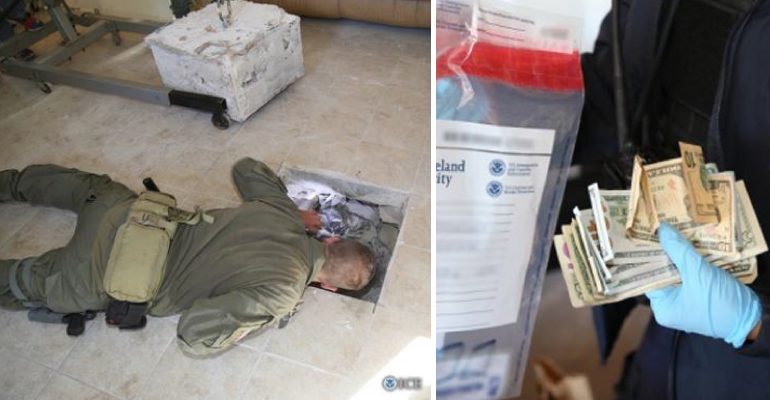
Federal officials seized a cross-border tunnel Wednesday morning following a lengthy multiagency investigation that resulted in six arrests and the confiscation of more than a ton of marijuana. Two women, Marcia Manuela Duarte-Medina and her mother Eva Duarte De Medina, were arrested in Nogales, Arizona, Tuesday night in connection with the tunnel.
The tunnel, more than 400 yards in length, stretches from the former El Sarape Restaurant, now a coffee shop, in Mexicali, Mexico, to a two-bedroom Calexico residence located at 902 E. Third Street, about 300 yards north of the international border. In the front room of the residence, agents found a hole concealed in the floor about three feet in diameter with an opening that descends several feet beneath the foundation.
Two men, Joel Duarte Medina and Manuel Gallegos Jimenez, were taken into custody Wednesday morning in Calexico. Gallegos was encountered at the tunnel residence, while Duarte was arrested at a home located on Horizon Street where authorities recovered more than 1,500 pounds of marijuana. All four defendants are charged by federal complaint with drug trafficking, money laundering, and tunnel-related offenses. The remaining two suspects tied to the case were detained by Mexican authorities in Mexicali Wednesday morning.
This is the first operational tunnel discovered in Calexico in a nearly a decade. According to federal investigators, it also represents the first time drug traffickers are known to have purchased property and constructed a house for the sole purpose of concealing the exit of a subterranean drug tunnel. The search warrant affidavit and charging documents allege the traffickers scouted properties in the area and selected the Third Street parcel in a residential section of Calexico. The sale of the property for $240,000 was finalized by the defendants in April 2015.
Court documents describe how special agents with U.S. Immigration and Customs Enforcement’s (ICE) Homeland Security Investigations (HSI) used court-authorized wiretaps and other investigative techniques to monitor the construction of the house during October and November of 2015. According to the case affidavit, the property owners told the construction contractor to leave a space for a floor safe when pouring a cement foundation for the house. Investigators believe the owners intended to use the hole in the foundation as the tunnel’s exit point. In late December 2015, coconspirators rented a “walk behind saw and concrete blade” from a local business in El Centro, presumably to create the tunnel exit. The residence was completed in December 2015 at a cost of approximately $86,000.
Once the house was finished, the drug trafficking organization opened the tunnel’s exit point in preparation for smuggling activity. Based on intercepted calls and surveillance, investigators believe the traffickers began transporting narcotics through the tunnel after Feb. 28. Investigators are confident that was the first time the tunnel was used.
On March 7, HSI special agents and the West Covina Police Department seized over 1,350 pounds of marijuana that had been smuggled through the tunnel and transferred to the two storage locations before being transported to Los Angeles via Brawley. This is the only known instance where traffickers moved narcotics from the Calexico storage locations to onward locations for distribution.
According to court records, the drug traffickers used the residence where defendant Duarte was arrested, located at 1056 Horizon Street, to store smuggled narcotics. Eventually, the traffickers moved the contraband from that location to a nearby warehouse at 260 Avenida Campillo where it remained until it could be moved north by the ring’s transportation cells. The trafficking organization used multiple storage locations and multiple drivers as a means of compartmentalizing their operations to keep various players in the dark about their methods.
The passageway shuttered in Calexico Wednesday is the 12th large-scale, operational drug smuggling tunnel discovered along the California-Mexico border since 2006. The majority of these passageways have been detected in the Otay Mesa area of San Diego, where the terrain is easier to excavate and the thousands of warehouses on either side of the border provide camouflage for illicit activities.
